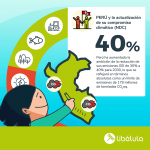The emissions reduction proposals of 36 countries in simple
With the expiry of the Kyoto Protocol in 2020, on the verge of an international legal vacuum linking international efforts to reduce greenhouse gas (GHG) emissions and in the run-up to the Convention of the Parties in Paris (COP21), 36 countries have made public their commitment to reduce emissions through ‘Intended Nationally Determined Contributions’ (INDCs). But what are they and why are they so important?
Contributions in simple
Nationally determined contributions‘ are the commitments that countries submit to reduce greenhouse gases (GHG) according to their realities, through mitigation actions.
The term “contribution” means commitment and contributions to mitigation. However, the concept of contribution used by each country is more or less broad according to its level of incorporation of the climate change approach into its territorial management. Indeed, some contributions also involve adaptation actions, while others incorporate the criterion of capacity building or investment in the implementation of clean technology.
The most important measure provided by the contributions is composed of a calculation of the country's emissions, which combines data from various sectors of national production; and then a reduction target is set against a base year or against a projected scenario showing the emissions trajectory in the absence of mitigation measures, i.e., the Business as Usual o BAU.
“With respect to the problem of climate change, it is a matter of scientifically measuring the functioning of the planet as we know it,” explains María Elena Gutiérrez, Libélula's Research Manager, “and of ensuring that it does not reach its limits through the scientific monitoring of information and the incorporation of mitigation and adaptation policies, as well as incorporating clean technologies and, finally, through the incorporation of sustainability criteria in the economies of countries according to their socioeconomic realities”.
Therefore, each country's emissions reduction target “must be ambitious and fair”. One of the main achievements of COP20 in Lima was to agree that these two criteria should be the horizon of understanding for all ‘nationally determined contributions’.
Country by country
Switzerland, for its part, has committed itself to reducing its GHG emissions by 50% by 2030 compared to 1990. This is a particularly ambitious and fair proposal, as it specifies that 30% will be achieved at home and 20% abroad, because Switzerland is responsible for far more emissions than it produces locally. In other words, it considers the territorial criterion in its contributions and, in addition, incorporates the consumer criterion: it is not only responsible for what it emits within its territory, but also for the emissions it consumes.
The European Union (28 member states) and Norway will reduce their emissions by 40% by 2030 compared to 1990 emissions. Despite all the ups and downs in the brief negotiating history, the EU and Norway have been parties that have honored their commitment.
Of the developing countries, Mexico sets a valuable precedent. It is a country highly vulnerable to climate change with per capita emissions of 5.9 tCO₂ and yet its target is to reduce unconditionally 25% of GHG and SCLP (short-lived climate pollutant emissions) emissions relative to BAU by 2030, a percentage that could be raised to 40% on a conditional basis, subject to a global climate agreement with certain conditions.
This is the first time that a proposal for unconditional reductions has been included, i.e., that they will be met regardless of whether or not a legally binding international agreement is reached. It also introduces the measurement of Black Carbon, emissions, soot produced by incomplete and inefficient combustion of fossil fuels, biofuels and biomass. A very important measurement object for developing countries that, by definition, have not succeeded in developing an efficient industry.
Once the largest emitter of GHGs, the U.S. proposes to reduce its total emissions by 26%-28% by 2025 compared to 2005, which is double the planned cut between 2005 and 2020, a comparison announced by President Barack Obama in November 2014 during the APEC (Asia-Pacific Economic Cooperation) summit.
The fact that the US has offered its contributions is already a turning point, since it had always been reluctant to sign an explicit commitment on GHG emissions reduction, even in 2005 the Kyoto Protocol was ratified without Washington's signature, and despite being the second largest emitter of CO₂, only recently surpassed by China.
But with China and Russia in the race to decarbonize the economy, the US could not be left behind. U.S. President Barack Obama and his Chinese counterpart Xi Jinping announced during last year's APEC summit, an agreement to jointly reduce GHG emissions, which is a positive symptom.
For its part, the Principality of Liechtenstein, one of the smallest countries in the world, committed to reduce its GHG emissions by 40% by 2030 compared to 1990 levels, and Andorra to reduce its “unabsorbed” emissions by 37% compared to the BAU scenario by 2030, focusing on the energy and waste sectors, responsible for more than 98% of the country's total emissions.
Forests and their power
Russia, for its part, has set itself the target of reducing its emissions by 20% to 25% by 2030 compared to 1990. It is worth noting its large forest capital, with 70% of boreal forests and 25% of the world's forest resources, which is a source that reverses the harmful effects of GHGs.
Regarding the efficiency of forestry policies as mitigation measures, the contribution of the African country of Gabon is particularly interesting: it registers a drop from 78,000GgCO₂ in 2003 to 28,000GgCO₂ in 2005. According to the Libellula research team, this is due to the forestry policies implemented by the Gabonese government in 2001, most notably the nationalization of 13 nature reserves. Gabon aims to reduce emissions by 50% relative to BAU by 2050.
Topics not very present
It should be noted that only two countries included adaptation and financing actions to combat climate change: Gabon and Mexico.
Mexico has had three National Climate Change Strategies since 2000, a Special Climate Change Program since 2009, and a National Climate Change Plan since 2008. General Law on Climate Change approved in 2015, becoming the first developing country to have a comprehensive law on climate change. Among the adaptation measures in its INDC, it proposes to strengthen the adaptive capacity of at least 50% of the municipalities (160) categorized as “most vulnerable”, establish early warning systems and achieve zero deforestation by 2030.
Gabon, for its part, proposes adaptation actions as well as financing mechanisms. It will incorporate the climate change approach through the implementation of a country development strategy, mainly focused on the coast.
In terms of financing mechanisms, Gabon is proposing the creation of a National Sustainability Fund that would combine private investment, national revenues and donations with the state budget, all with a view to combating climate change within its territory.
The carbon credit mechanism has only been included by Switzerland and Norway. As Maria Elena Gutierrez explains, “this is because there is no carbon market as such, there is no supply and demand for carbon credits. This is due to the fact that no maximum emissions ceiling has been established for the emitting countries above which it is necessary to buy carbon bonds issued to counteract the harmful effects of the GHGs they emit”.
Towards final measurement
All these reduction proposals comply to some extent with being “fair and ambitious”. They also provide the initial information on the basis of which, later this year in Paris at COP21, a new legally binding agreement will be generated that respects the responsibility of each country according to the principle of “Common But Differentiated Responsibilities and Respective Capabilities (CBDR-RC)".
In the final stage of this collaborative process of global emissions measurement, the contribution figures expressed in different metric units, with different base years and measuring very different productive sectors from country to country, will require a complex system of equivalence, evaluations and measurements that will be in charge of the Intergovernmental Panel on Climate Change (IPCC) to achieve a global figure.
The ultimate goal then, broadly speaking, will be to measure the total emissions expelled into the atmosphere and calculate whether or not the efforts of all countries to keep global warming below 2°C compared to the pre-industrial era are sufficient to maintain the planet and its ecosystems as we know them.
Contributions submitted to date can be consulted at this website.
Additional data
- Although China has not presented its contributions, during the APEC (Asia-Pacific Economic Cooperation) summit in November 2014, President Xi announced that China's emissions levels will peak in 2030 and then decline, with 20% of energy coming from clean and renewable sources by then.
- Black Carbon or soot, is carbon in a gaseous state, with a 2.5 MP component (particulate matter found in the air measured in the unit of length called microns) capable of retaining light and transforming that light into heat and therefore has a high potential for climate change.
By: George Simons



